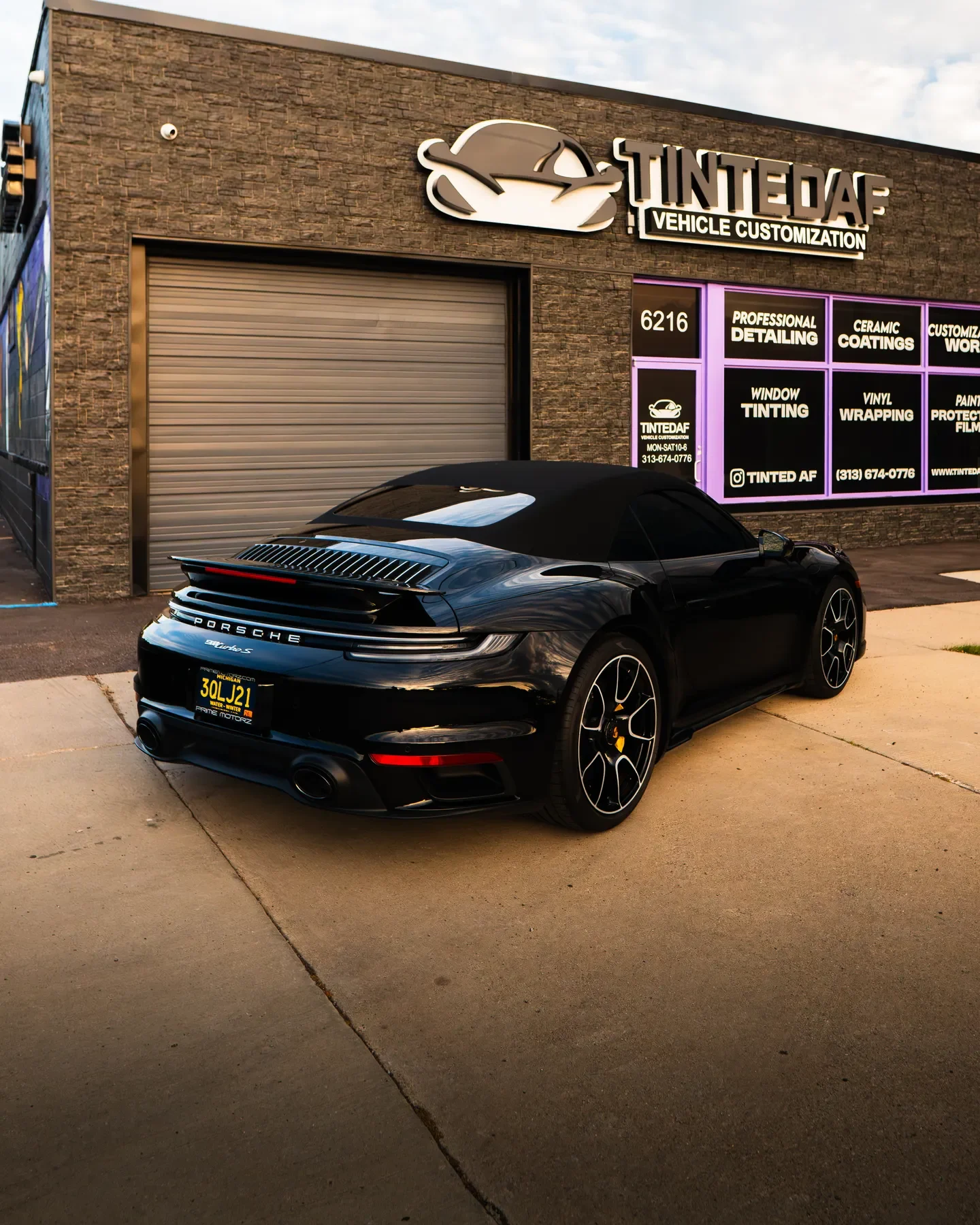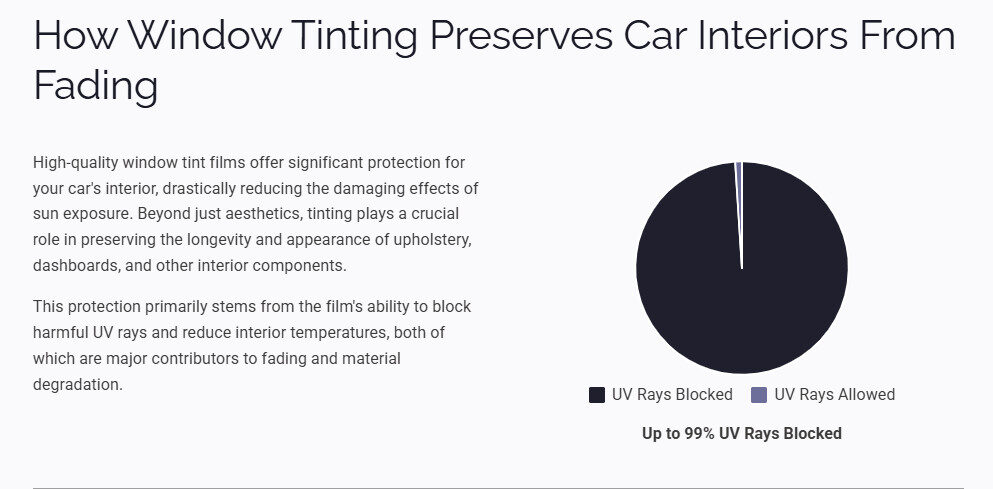Sunlight provides warmth and brightness, but it also carries ultraviolet (UV) rays that can slowly harm vehicles and their occupants. While car glass offers some protection, it does not fully block UV radiation. For drivers seeking Window Tinting in Dearborn, this article explores how tinting safeguards both health and interiors. With trusted expertise from TintedAF, we’ll look at why tinting is more than just a cosmetic choice.

Understanding How UV Rays Affect Vehicles
What Ultraviolet Radiation Really Means
Ultraviolet rays are invisible parts of sunlight that carry strong energy. Although we cannot see them, they can damage skin, eyes, and surfaces with constant exposure. Cars, like people, need protective barriers against these harmful wavelengths.
How UV Rays Pass Through Glass
Vehicle glass acts as a filter but does not block all radiation. While windshields have some UV resistance, side and rear windows usually allow most rays to pass through. Over time, this invisible exposure builds damage inside the car.
Exploring The Hidden Risks Of UV Exposure
How UV Affects Driver And Passengers
Sitting in traffic or commuting long hours means extended UV exposure for drivers and passengers. This can lead to premature wrinkles, skin damage, and greater risk of long-term conditions. Even short daily trips accumulate exposure across the years.
Interior Fading And Visible Deterioration
UV rays also target upholstery, trims, and dashboards. Fabrics fade, leather weakens, and plastics crack under constant sunlight. Without tinting, interiors age quickly, lowering comfort and overall vehicle condition.
Explaining The Science Of Window Tinting Films
How Tinting Technology Blocks Harmful Rays
Modern tinting films are designed with protective layers that filter UV radiation. Ceramic films are especially effective, blocking up to 99% of harmful rays while keeping visibility clear. This allows safety and comfort without darkening glass excessively.
Different Levels Of UV Protection Available
Not all films provide th
e same shield. Dyed films mainly reduce glare, hybrid films add more strength, and ceramic films provide the highest level of protection. Understanding film differences ensures smarter and longer-lasting choices.

Examining The Long-Term Health Advantages
Reducing Risks Of Skin Conditions
Even when driving indoors, exposure to UV rays is ongoing. Over years, this can cause sunburn, early wrinkles, or worse conditions. Tinting functions like a permanent sunscreen layer for drivers and passengers alike.
Protecting Vision During Daily Driving
UV rays also harm vision, especially with glare on bright days. Tint reduce eye strain and shield eyes from harmful radiation, lowering the chance of cataracts or other long-term damage.
Highlighting The Interior Preservation Benefits
Preventing Upholstery Fading And Damage
Car seats are quick to fade when exposed to sunlight. Whether fabric or leather, materials weaken under UV exposure. Tinting keeps colors bright and maintains seat comfort for longer.
Safeguarding Dashboards And Panels
Dashboards are highly exposed through windshields, making them prone to cracks. Tinting reduces heat buildup and blocks UV rays, preserving both strength and appearance of the vehicle’s most visible surfaces.
Understanding Why Dearborn Drivers Benefit More
Michigan Climate And Seasonal Sun Intensity
Dearborn weather changes often, but UV radiation remains present year-round. From snowy months to bright summers, tinting ensures consistent protection for drivers no matter the season.
Long Commutes And Urban Traffic Exposure
Extended drives on highways and through city traffic increase UV exposure. For Dearborn drivers who commute daily, tinting provides lasting defense against health risks and interior fading.
Exploring Practical Tips For Choosing Window Tinting
Selecting The Right Type Of Film
Different films provide different benefits. Ceramic films deliver the best UV protection, while dyed options are more basic. Choosing carefully ensures balance between protection, visibility, and legal compliance.
Maintaining Tint Films For Lasting Results
With simple care, tint films remain effective for years. Cleaning with ammonia-free products and avoiding scratches preserves their clarity and durability. This keeps the protective barrier strong over time.
Knowing Legal Guidelines For Michigan Drivers
State laws regulate how dark tinting can be for safety. Michigan allows certain limits on side and rear windows, while windshields are more restricted. Staying informed ensures drivers remain compliant and protected.
Clarifying Myths Around Window Tinting Protection
Does Tinting Reduce Nighttime Visibility?
High-quality films are designed to maintain clear visibility at night. Unlike cheap, overly dark tint, advanced ceramic films strike a balance between protection and safe driving after sunset.
Is Window Tinting Only About Looks?
While tinting often improves vehicle style, its primary function is protection. Reducing UV damage, glare, and interior fading are the true advantages that go far beyond appearance.
Are All Tint Films Built The Same?
Films vary in quality and effectiveness. Budget options may bubble or peel, while premium films like those used by TintedAF provide superior UV protection and durability that lasts for years.
Reviewing The Ongoing Impact Of Window Tinting
Supporting Healthier Driving Experiences
Tinting lowers glare and reduces UV exposure, making driving more comfortable. Over years, this consistent shield supports healthier skin, safer vision, and less driver fatigue.
Preserving Vehicles For Extended Lifespans
A tinted vehicle maintains interior strength and comfort longer than untreated cars. From upholstery to dashboards, tinting helps extend both function and style.
Learning About Energy Efficiency Advantages
Lowering Cabin Temperature Naturally
Tinting reduces heat buildup inside cars by blocking infrared rays along with UV radiation. Cooler interiors reduce reliance on air conditioning, helping vehicles run more efficiently.
Supporting Eco-Friendly Driving Habits
With less demand on the air conditioning system, cars consume less fuel during hot months. This simple protection method indirectly supports greener and more sustainable driving practices.
Discovering Additional Safety-Related Benefits
Strengthening Glass Against Shattering
Tint films add a layer that holds glass together in accidents. While not unbreakable, tinted windows reduce the risk of shattered glass scattering inside the vehicle, offering extra protection.
Improving Driving Focus On The Road
Reduced glare and consistent cabin comfort mean drivers remain more alert and less distracted. This creates safer driving conditions for long commutes and daily travel alike.
Understanding The Role Of Modern Innovations
How Nanotechnology Improves Film Design
Many advanced tint films use nanotechnology to enhance UV and infrared blocking. These tiny particles increase performance without darkening windows excessively, keeping visibility high.
Why Longevity Has Improved With New Films
Older films often faded within a few years, but modern options are engineered to last. Ceramic and hybrid technologies extend protection, keeping vehicles shielded for nearly a decade or more.
TintedAF Serving the Cherry Hill Village Community and Beyond in Canton Township, MI
TintedAF is dedicated to serving the diverse needs of the local community of Canton Township, MI , including individuals residing in neighbourhoods like Cherry Hill Village. With its convenient location near landmarks such as the Independence Park, Heritage Park and major intersections like Cherry Hill Rd & S Beck Rd and Ridge Rd & Denton Rd (coordinates: 42.288309434471024, -83.51563261876431), we offer window tinting services.
Get window tinting Services at Cherry Hill Village Now
Navigate from Cherry Hill Village to TintedAF Now
How Window Tinting Preserves Car Interiors From Fading
- Up to 99% UV Rays Blocked by high-quality window tint films, drastically reducing sun damage to upholstery and dashboards.
- 60% Less Interior Fading observed in tinted cars compared to untinted ones, according to recent studies.
- Interior Temperature Reduced by 30-50%, lowering heat stress that accelerates cracking and discoloration of leather and vinyl.
- Premium Ceramic Tint Last 10-15 Years maintaining protection and appearance, while cheaper dyed films fade within 5-7 years.
[Chart Visualization Suggestion:]
- Bar chart comparing % interior fading: Untinted (100%) vs Tinted (40%)
- Pie chart showing UV rays blocked by tint (99%) vs allowed (1%)
- Line graph illustrating temperature inside car with and without tint over a sunny day


Source: Endless Detailing WI (2024), Metropolitan Tinting (2025), HH Ceramic Coatings (2025)
Educational Takeaway For Dearborn Drivers
UV rays may be invisible, but their impact on health and vehicles is constant. Through Window Tinting Dearborn, drivers gain year-round protection against sun damage while also preserving their car’s interior. With advanced solutions from TintedAF, window tinting stands as both a protective measure and a practical upgrade for safer, healthier, and more comfortable driving.
Frequently Asked Questions
Q1: Does window tinting block all UV radiation?
High-quality films block up to 99% of harmful UV rays, offering near-complete protection.
Q2: Can UV rays still cause harm in winter?
Yes, UV rays remain active even during cold seasons, making year-round protection necessary.
Q3: How long do ceramic films last in Michigan weather?
With proper care, ceramic tint can remain effective for 8–10 years.
Q4: Does tinting affect electronic devices inside cars?
Ceramic films do not interfere with GPS, radios, or smartphones, unlike some metallic films.
Q5: Can tinting help reduce eye strain for daily drivers?
Yes, tinting reduces glare, protecting the eyes and making long commutes more comfortable.
Our Other Blog Posts Related Window Tinting
Why Daily Commuters Should Consider Window Tinting For Skin
Why Window Tinting Improves Privacy Without Blocking Visibility
How Window Tinting Helps Ease Eye Strain During Extended Driving

